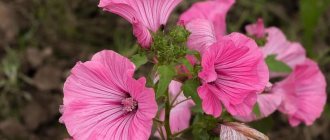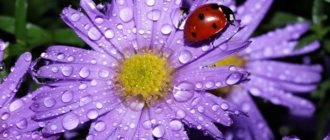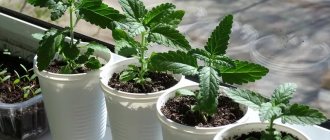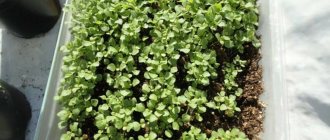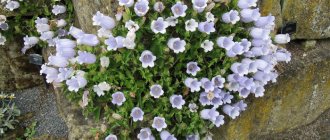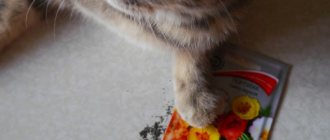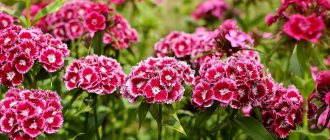- March 4, 2019
- Flowers
- Anastasia Efremenkova
Eschscholzia, or California poppy, is a garden plant belonging to the Poppy family. There are about a dozen varieties in total, which primarily grow in Western North America. There is an ancient legend that says that once in the distant 16th century, the Spaniards arrived on the shores of America, traveling in search of gold. 35 miles from the coast they noticed a yellow glow, which they mistook for gold and immediately rushed to the shores of California. But when they arrived there, they saw that it was just the fields of Eschscholzia that were golden. This shrub is an unpretentious plant; it blooms profusely and for a long time: from the beginning of June until the onset of the first frost. Although it is worth noting that one flower lives no more than four days, however, as soon as it fades, a new one appears in its place.
Description of the plant
The eschscholzia flower is a perennial herbaceous shrub that has a tap root. The stems of the plant are not too tall and reach only forty centimeters in height; in culture they are often grown as annual species. The shrub has numerous thin shoots, on which there are bluish-green lacy leaves with long, deeply dissected petioles. The flowers are cup-shaped, solitary, no more than eight centimeters in diameter. They can be simple or terry, depending on the type. Outwardly, they are very similar to poppies, but are colored yellow, orange and red, as well as in their various shades.
Eschscholzia flowers have one peculiarity - they close at night, as well as during cold and windy periods. It has a plant and a small fruit (from three to nine centimeters in size), which has the shape of a box.
Popular varieties
Eschscholzia has many varieties, but only a few of them are suitable for the Russian climate, and yet there is a large selection, a wide variety of colors, shapes and sizes. Let's look at the most popular varieties among gardeners:
- Soddy. This variety is one of the dwarf representatives of the species. Each flower grows separately, the bright orange inflorescence reaches a diameter of about 3 cm. Flowering is abundant.
- Lobba. Miniature, but grows as a bush up to 20 cm tall. It looks exactly like a poppy, but the flowers are yellowish and 2 cm in diameter.
- Californian. It is very popular among gardeners due to its appearance and fairly large size (plant height reaches 45 cm, flower diameter up to 10 cm). The range of colors varies from golden to carmine, and also comes in white. It blooms for a long time and does not suffer from diseases.
- Ballerina. Because of the name alone, I want to grow this variety, which is a hybrid of terry Eschscholzia and ordinary ones. “Ballerina” grows in bushes up to 40 cm, the flower is up to 5 cm. Outwardly it resembles a rose or ranunculus, due to the dissected terry petals, the color is pink, bright yellow or orange.
- Cherry swirl. The variety is distinguished by its unusual color - a gradient from yellow in the center to scarlet. It grows as a medium-sized bush, similar to wild poppy.
Eschscholzia Apple blossom. The buds of the variety's plants are similar to apple blossoms, hence the telling name, but their diameter is more than 10 cm. The variety is densely double
Growing Eschscholzia from seeds (when to sow)
Quite often the plant is planted directly in open ground. In such cases, gardeners have a question: “When to sow Eschscholzia in open ground in order to achieve maximum seed germination?”
You can do it before winter (in October), then the seeds will undergo natural stratification, and in the spring you will be able to admire the strong seedlings that will need to be thinned out, ridding the beds of weak shoots. In addition, a plant planted in the fall will begin to bloom much earlier than one sown in the spring. Many gardeners who were looking for an answer to the question of whether it is possible to sow eschscholzia before winter will now safely do so.
If you decide to plant seeds in the spring, you will need to prepare for planting. To do this, put the planting material in the bottom drawer of the refrigerator and keep it there until April - this is not only a way to preserve their germination, but also an excellent option for stratification. This way you will “kill two birds with one stone”.
Before you start planting seeds, you should choose a suitable place for Eschscholzia. The site should be sunny, the soil dry and sandy. You should prepare in advance not too deep grooves in the soil, where you then need to lay out the seed. Don't forget to mix the seeds with sand. Then cover them lightly with loose soil and lay out a small layer of peat mulch. This is necessary to ensure that the soil does not harden. Otherwise, the seedlings may simply not break through. If you choose autumn planting, then it is recommended to use dry leaves as mulch, which are laid out in a thick layer on the beds. This is how caring for and planting eschscholzia in open ground occurs directly from seeds. Now let’s take a closer look at the option with seedlings.
Seedling
Despite the fact that the method of planting seeds in open ground is very simple and popular, experienced gardeners prefer to grow seedlings. Further in the article we will consider the process of growing eschsolzia from seeds at home into seedlings.
At the beginning of the article it was mentioned that the plant has a long tap-shaped root, which can be severely damaged during transplantation. To avoid this, you should plant the seeds for seedlings in peat tablets. But first, it’s worth learning more about growing eschscholzia from seeds (when to plant and how) to obtain seedlings.
The worst days of 2022 for planting eschsolzia
It is believed that the most infertile sign of the zodiac is Aquarius. On days when the Moon is in this sign, it is better not to take any landing actions. The plants will not take root well. Also signs with a reduced level of survival are Aries, Leo and Sagittarius.
The favorability of certain zodiac signs is still a topic of debate. You can only understand what is truth and what is fiction through your own experience.
We invite you to familiarize yourself with the unfavorable dates for planting in 2022:
| Month | Unfavorable days for planting seeds for seedlings and transplanting into the ground |
| February | 7-11, 21-25 |
| March | 7-11, 19-25 |
| April | 6-10, 15-17, 21-24 |
| May | 6-8, 13, 14, 21-24 |
| June | 4-7, 9-11, 19-22 |
It is also not recommended to manipulate plants on full and new moon days.
How much should you trust the lunar calendar?
Experienced gardeners will say that they use the advice of the lunar calendar every year and do not have headaches with the timing of dacha manipulations. After all, the calendar already clearly states when what can or cannot be done. It is possible that they are right. But there is another “army” of plant growers who will disagree and say that the Moon should not be trusted 100%. After all, weather conditions and region play a significant role in the timing of planting. We recommend trying different options and drawing your own conclusions.
Disembarkation procedure
There is a certain procedure for planting Eschscholzia seeds in peat tablets. First, place the tablets in a container and pour some water into it. The tablets should absorb the liquid after a while. All remaining water should be drained. Next we sow Eschscholzia. Each tablet contains one seed. To do this, it is customary to use a toothpick, since the eschscholzia seeds are quite small and it is not very convenient to pick them up with your fingers. Please note that the toothpick must be wet so that the seeds stick to it. The seeds should be sprinkled on top with a small amount of soil intended specifically for growing seedlings. Afterwards, watering should be carried out. To do this, use a spray bottle. Next, the container must be covered with transparent film or glass to create a greenhouse effect.
You will see the first shoots in two weeks. Once they appear, you can safely remove the coating from the container. Now the gardener should be interested in the question of when to plant Eschscholzia from seeds for growing seedlings in open ground.
Hello, dear readers!
Until recently, I did not plant Eschscholzia on my plot. And even now I don’t understand why.
But two years ago, while looking through another catalog of flower seeds, I unexpectedly saw (as if a veil had fallen from my eyes) eschscholzia.
And from now on, I can no longer imagine my garden without eschscholzia - a sunny flower that enlivens everything around.
When the Eschscholzia blooms, many little suns light up on the summer cottage, transforming it fabulously.
A person perceives the main flow of information through vision
It is important that this foundation is mostly filled with positivity.
That’s why we take into our sight an unpretentious, pleasant-looking flower: eschscholzia.
A relative of the poppy (poppy family), delicate and varied in color shades, Eschscholzia came from afar.
The birthplace of the flower is northwest America. It is named after the surname of the Russian scientist Eschscholtz who discovered the flower in the 7th century.
Seedling care
Seedlings require special conditions for their normal development. So, the container with the tablets should be moved to a bright place where the air temperature will not fall below 20 degrees Celsius. Now the gardener’s task is to moisten the soil when necessary and also apply fertilizers. Liquid mineral nutrition for seedlings is applied two weeks after the first shoots appear.
Think in advance about when you will plant the seedlings in open ground, so that you can start hardening the seedlings three weeks before. To do this, they are taken out into the fresh air or into a cool room during the day and left for several hours. If you have carried out the hardening correctly, then the seedlings will not be afraid of a drop in temperature to minus five degrees.
Seedling method
This method is preferable if the American will be part of a decorative ornament. For this purpose, strong “kids” are needed.
Stratification of planting material
To obtain healthy and strong young animals, it is necessary to harden the grains using cold and saturate them with moisture. The process is carried out in the following sequence:
- sterilize the substrate; sand, peat, vermiculite are suitable;
- soak the seeds in cold water for six to twelve hours; freshly harvested ones do not need additional moisture;
- after this, the planting material is laid out in the soil, placed in the refrigerator and checked regularly; if necessary, moisturize;
- after the appearance of rudimentary roots, the boxes are dug outdoors under the snow or moved into the glacier;
- before planting, the grains are sifted out;
- the stratification process ensures endurance and rejects low-quality “embryos”.
When to sow seeds for seedlings
It is optimal to hold the event in March. It is best to sow in peat tablets. This method allows you to avoid additional problems with transplantation. The root system of young animals will not be damaged by movements from one place of residence to another. The technology is very simple:
- The tablets are placed in a container and filled with water. After some time, the washers will swell. The remaining moisture must be removed.
- Only one grain is placed in each. To do this, it is convenient to use a wet toothpick.
- The top is lightly sprinkled with purchased soil for seedlings.
- Water by irrigation from a fine spray bottle.
- Cover the container with glass or film to create a “greenhouse effect.”
- After the first growth appears, the covering material is removed. The box is moved to a well-lit place and the temperature is maintained at no higher than 20⁰C.
Seedling care
During this period, the optimal humidity of the substrate is maintained through regular irrigation. “Teenagers” are fed with liquid mineral fertilizer within half a month after the first shoots appear.
Three weeks before moving to open ground, the young animals begin to be hardened. To do this, the containers are taken out in the daytime for several hours in a cool place. After such exposure, the “babies” will be able to withstand frosts down to -5⁰C.
Eschscholzia seedlings - growing secrets
By following a number of simple rules, propagation of the Californian beauty will not be difficult. The main recommendations of experienced flower growers are as follows:
- Do not bury seeds in the ground.
- It does not tolerate stagnant moisture, so planting in an extremely water-saturated substrate does not promise success. For the same reason, excessive or too frequent watering is extremely unacceptable.
- It is better to plant only one grain at a time. In case of thickening, the “babies” are not subject to transplantation.
- The “teenagers” are transferred along with the peat tablet to a prepared flower bed in the garden.
When to plant Eschscholzia
It is necessary to plant Eschscholzia in dry, sandy soil with a good drainage layer. The reaction must be neutral or slightly acidic. If the soil on your site is too acidic, then you should dig it with a shovel full and at this depth lay out dolomite flour at the rate of 200 grams per square meter. Flour can be replaced with ash. For one square meter of land you will need two cups of ash. Seedlings can be planted from late April to mid-May. This is the period when frosts no longer appear at night, but the earth is not yet completely warmed up.
Choosing a landing site
Eschscholzia blooms profusely only in sunny places. Flowers bloom from 10.00 to 16.00, then close.
On cloudy days, you can forget about the beautifully blooming Eschscholzia. This is a drawback, because in rainy summers Eschscholzia blooms little.
There are no special requirements for the substrate; it is desirable that the soil for Eschscholzia be:
- permeable;
- light;
- carbonate;
- quite dry.
Eschscholzia grows well in less nutrient-rich soils and even sandy soils, but produces smaller flowers. Flowers will be larger if the soil is amended with compost.
Seedlings (growing)
We found out when to plant Eschscholzia from seeds, and also learned how to grow seedlings at home, and now we’ll look at how to move them outside. You should prepare for disembarkation in advance. It is necessary to dig holes at a distance of 30 centimeters from each other, since adult bushes have a rather spreading shape. The seedlings are placed in the existing recesses directly with peat tablets, then sprinkled with loose soil and compacted on top. After this, it is imperative to water the area. The first flowering will appear 30-40 days after sowing.
Eschscholzia care
Caring for Eschscholzia in the open ground is not too difficult and anyone, even a novice gardener, can cope with it. So, seedlings need regular loosening of the soil, as well as fertilizing. The plant needs to be watered only if there is a prolonged drought outside. If it rains periodically, then this moisture will be quite enough for the plant.
If you want to achieve long and abundant flowering, then before planting seedlings in the soil you should add a multicomponent mineral fertilizer, which will contain potassium, nitrogen and phosphorus, as well as microelements or an infusion of ash, which is prepared in a ratio of 1:10.
When growing eschscholzia on your plot, do not try to fertilize it using organic fertilizers. This can even lead to the death of the plant. It should be noted that eschscholzia actively reproduces by self-sowing; if you are against this, then immediately after the flower withers, you should remove it from the bush so that the seed pod does not have time to form.
If the plant has completely bloomed, then old shoots should be removed. Many species of Eschscholzia quickly restore lost stems.
Eschscholzia: planting and care in open ground, application in garden design
Eschschólzia is a plant from the Poppy family. Brought to our country in the mid-19th century. Includes about 10 species. These colorful flowers are native to western North America. In Russia, eschscholzia is used as an annual plant, despite the fact that in its homeland the plant is perennial. The popular name for this American plant is “California poppy.”
This herbaceous representative has strongly dissected leaves on long petioles. The flowers are cup-shaped, simple or double, reaching 5-7 cm in diameter. The flowering period is from late June to October. The color scheme is varied: shades of red, orange, white, cream. The final stage of flowering is the formation of a box with small seeds.
Eschsolzia: types and varieties
“California poppy” presents its diversity in several forms:
| View | Description |
| Eschscholzia turf | Distributed in California and southern Mexico. The leaf blade is divided into several lobes. Flowers yellow or orange |
| Eschscholzia californica | Initially found as a wild plant in California, Oregon, and Mexico. The favorite place of growth is waste land. The height of the plant reaches up to 60 cm. In inclement weather, the yellow-orange flowers close. The leaves are divided into many segments. It is an indispensable plant for creating interesting accents in landscape design. |
| Eschscholzia elegans | Shrub type. The plant is distributed only in Mexico. |
| desert poppy (Eschscholzia glyptosperma) | The height of the stem is 25 cm. The leaf mass has a dissected shape. Single flower of bright yellow color |
| Eschscholzia hypecoides | The distribution area is the coast of San Benito County. The stem is from 5 to 30 cm in height. The flower is yellow with orange splashes. Pinnate leaves with a blunt end. Loves moist soils |
| Eschscholzia Lemmona | Distributed in California. A low plant with small flowers 1.5-4 cm in diameter. Prefers to grow in open space |
| Eschsolzia Lobba | Similar in structure to its counterparts. A distinctive feature is the glossy leaves of the flower. |
| Pygmy poppy (Eschscholzia minutiflora) | Desert Flower. Differs from other species in the gray-blue color of the leaves. The flowers are small and yellow |
Diseases and pests
As you can see, growing and caring for Eschscholzia is not at all difficult, but only if the gardener strictly fulfills all the requirements for planting seeds, planting seedlings and subsequent care for them. If all these rules are not followed, then there is a high risk of encountering difficulties associated with the occurrence of various diseases.
At the beginning of summer, Eschscholzia is often attacked by bean aphids, which can be destroyed by spraying with the preparation “Commander”. If it’s a hot summer outside, then there is a chance that the plant will have spider mites, which can be overcome with the insecticidal preparation Actellik. Remember that watering should be moderate, otherwise there is a possibility of rotting of the root system and other parts of the plant. If this happens, then watering must be immediately reduced and all damaged areas of the flower removed to prevent the spread of rot throughout the bush. If the lesion was not noticed immediately and spread to the entire plant, then the specimen will simply have to be removed from the garden bed.
Eschscholzia can also be affected by powdery mildew. In this case, the bushes must be treated with sulfur.
Use in landscape design
The bright color of the petals, original openwork foliage, long flowering period and outstanding drought resistance have led to the widespread use of eschscholzia in flower arrangements.
The plant is used in decoration:
- mixborders,
- rockeries;
- alpine slides;
- rock gardens.
Eschscholzia is planted in combination with other low-growing plants: purslane, lobelia. Combines well with dwarf perennials: forget-me-nots, primroses, carnations. The bright flower looks great among the cereal grasses as part of the “Moorish lawn”.
Picturesque composition with eschsolzia
Any part of the garden will be decorated with a beautiful eschscholzia flower, growing and caring for which is not difficult. The plant propagates easily: it is enough to sow the California poppy once to admire its cheerful flowering for many years.
Properties of Eschsolzia
In addition to the specifics of caring for and planting eschscholzia in open ground, a gardener should know about its properties. The plant has been used by people for medicinal purposes since ancient times. The Indians took its above-ground parts and used it as a remedy for toothache, but the pollen was valued as a cosmetic product. A decoction of the flowers of this plant was also prepared to get rid of lice. Now in France, eschscholzia is grown specifically and then used to prepare various medicines. In America, preparations containing the plant are considered one of the best painkillers and sedatives. Such drugs have one great advantage - they have no side effects, which cannot be said about other benzodiazepine drugs.
Collecting seeds
If you plan to plant Eschscholzia seeds on your plot again next year, then it is not at all necessary to collect seed material, since the plant can give excellent self-seeding. This will save you from the unnecessary hassle of stratification, planting, etc. In the spring, you will only have to thin out the seedlings in the beds and calmly wait until the eschscholzia blooms.
In general, seeds are needed only in the first year of planting a plant on the site, and then you will no longer have to purchase them in the store. If you don’t trust self-sowing or want to transplant the plant to another area, then you will have to collect the seeds. It's not difficult to do this. Look for a few bushes in advance, put gauze bags on the wilted flowers so that the seeds do not spill out on the ground, and as soon as they ripen (about a month after flowering stops), the seed pods can be safely cut off, remove the gauze, and shake out the contents , preferably on newspaper, and then leave in a warm, dry place to dry. After this, the seed is collected in a paper bag and left in the bottom drawer of the refrigerator until spring, this was noted earlier in the article.
If the seeds were collected correctly and stored under normal conditions, their germination will continue for three years.
How to collect eschscholzia seeds
If you plan not to change the place where you plant Escholzia and leave everything as it was, then you shouldn’t collect the seeds at all. The plant itself will take care of its offspring. And self-seeding will help him with this. The only thing you need to do is thin out the seedlings after they sprout.
If you have chosen a different area for planting the crop, then you should collect the seeds. It is best to tie a small bag over the drying inflorescence and when the box opens, the fully ripened seeds will not spill out, but will end up in the bag. The seeds collected from the bags will be ready to become planting material after a short drying on an ordinary piece of fabric. They are stored in the bottom of the refrigerator for no more than 3 years. After this period, seed germination sharply decreases.
Types and varieties
In our area, only a few types of plants can be grown: Californian eschscholzia, turfgrass and Lobba, but the latter does not take root everywhere. Let's look at them in more detail:
- Eschsholzia Lobba. These are relatively low bushes that reach a height of 15 centimeters and have light yellow flowers with a diameter of 2 cm.
- Eschscholzia is turfy. The height is the same (15 centimeters). The leaves are bluish-green, thrice dissected, rather thin, covered with a waxy coating on top, and collected in a small rosette. Cup-shaped flowers create a kind of cap, quite lush, yellow in color. Each bud has a diameter of no more than three centimeters. This species begins to bloom in June and ends with the onset of the first frost.
- Eschscholzia Californian. In its appearance it resembles a wild poppy, which is why it received its second name - California poppy. This is a perennial creeping shrub that reaches a height of 40 centimeters. The stem is covered with ribbed shoots of bluish-green color, where dissected leaves of the same color are located. The flowers, nine centimeters in diameter, are cup-shaped and solitary. The color palette is quite extensive: yellow, white, orange, cream, carmine. Californian eschscholzia begins to bloom from the beginning of summer until the onset of the first frost.
Californian Eschscholzia has several of the most popular varieties:
- Strawberry Fields are semi-double buds that are bright red at the edges and yellow towards the center.
- Peach Sorbet is a terry Eschscholzia, which is strewn with lush cream-colored flowers.
- Apple blossom - got its name because of the shade of the buds.
- Eschscholzia Chiffon is a real mix of different species and varieties of plants, which creates incredible beauty and a variety of shapes and shades in the garden during flowering. The height of one bush reaches forty centimeters, the buds are mostly double and have beautiful corrugated edges. It begins to bloom at the end of May and until late autumn.
- Ballerina Mix is another mixture of varieties, which includes not only double, but also simple flowers of various shades. The diameter of one bud varies from five to eight centimeters, the bushes also have different heights - from 25 to 40 centimeters.
So we learned all the features of growing eschscholzia from seeds (when to plant, where and how) on the site, and also got acquainted with the most common plant species and varieties in our latitudes.
Reviews
- Irisana: My mother considers Eschscholzia a weed, but I specially bred it at the dacha and it makes me happy with its bright flowers. I have sowed and sowed it directly into the ground in early spring, using my own seeds. The main thing is not to miss the moment to collect them - they ripen in small pods that quickly dry out and burst. Although this is not a problem - it turns out that the seeds overwinter well in the ground; as soon as it gets warm, stems appear from the ground. I love Eschscholzia, it’s just a pity that the flowers don’t last long.”
- Che!, Yekaterinburg: “Eschscholzia is an unpretentious, but very beautiful flower. This is a self-sowing plant, but you can specially sow it before winter - then it will bloom in June and will show off in the flowerbed until the end of September. But she doesn’t like transplanting, so I don’t plant her with seedlings.”
- KlimN, Ukraine: “California poppy is, in general, an unpretentious plant, but it just loves the sun very much. In a flowerbed that was exposed to the sun only half the day, it grew very poorly for me. And in open areas there are bright and wonderful flowers.”
Eschscholzia is a cold-resistant annual. In cloudy, rainy weather, as well as at night, the buds close. Each flower lives only 3-4 days, but it is quickly replaced by several others. Until the frosts, you will be able to see delicate flowers continuously blooming in your area.

